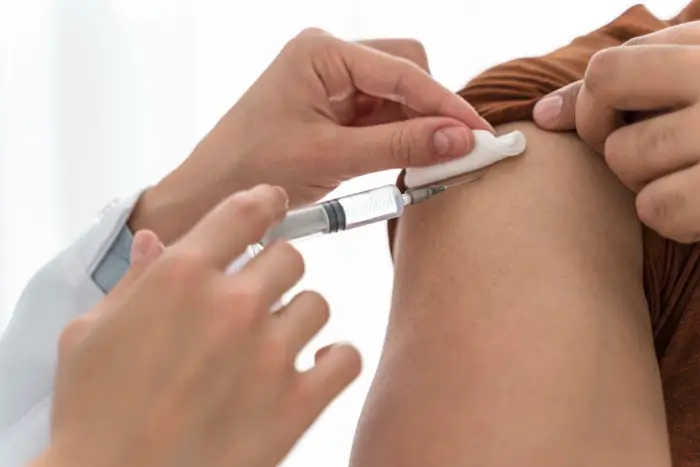Only for Licensed Professionals
Only for Licensed Professionals
.webp)
What Is Xolair?
David Fuller
Last Updated On: September 30, 2025
Food allergies affect millions of people in the United States, sending tens of thousands to emergency rooms each year after accidental exposure. These numbers show just how disruptive and potentially dangerous IgE-mediated allergies can be, especially since options for prevention have traditionally been limited to strict avoidance.
Xolair (omalizumab) offers a new approach. This monoclonal antibody therapy works by targeting immunoglobulin E (IgE), the antibody responsible for triggering allergic reactions. By blocking IgE from attaching to immune cells, Xolair lowers the chance and severity of allergic responses, including anaphylaxis, when an allergen is encountered.
In this article, we’ll take a closer look at Xolair: what it is, how it works, the conditions it can treat, and what patients and providers should consider when weighing its benefits and potential risks.
Key Takeaways
- Xolair (omalizumab) is a biologic therapy that targets IgE, the antibody responsible for many allergic reactions.
- It has FDA approval for allergic asthma, chronic spontaneous urticaria, nasal polyps, and IgE-mediated food allergies.
- Xolair dosing depends on the condition: weight and IgE levels for asthma, fixed doses for urticaria, and weight plus IgE for food allergies.
- Treatment is given by subcutaneous injection every 2–4 weeks, often starting in a clinic due to the risk of anaphylaxis.
- Clinical studies have shown that Xolair can reduce flare-ups, improve daily control, and lower the risk of severe allergic reactions.
- While generally safe, risks include injection-site reactions, rare anaphylaxis, and possible long-term concerns that require monitoring.
- By improving both symptom control and quality of life, Xolair has become a cornerstone option for patients whose allergies are not well managed with standard therapies.
About: Operating since 2016, Med Supply Solutions is known for being one of the industry’s top and trusted suppliers of cosmetic and viscosupplementation products. If you’re looking to buy Xolair online, contact our sales department for more information.

Mechanism of Action of Xolair: Targeting IgE in Allergic Pathways
Understanding how omalizumab works is central to answering the question, “What is Xolair?” Many allergic diseases are driven by IgE antibodies, which attach to allergens and activate mast cells and basophils. This triggers the release of histamine and other inflammatory mediators, leading to asthma attacks, hives, or severe food reactions.
How Xolair Acts on IgE
- Xolair binds free IgE, blocking its interaction with FcεRI receptors on mast cells and basophils.
- This downregulates receptor expression and reduces the release of inflammatory mediators.
- Over time, free IgE levels decrease, while total IgE may appear higher due to the formation of drug–IgE complexes.
This targeted approach makes Xolair more precise than steroids or antihistamines, offering long-term disease control for carefully selected patients.
FDA-Approved Indications for Xolair: Asthma, Urticaria, Food Allergy

When considering the uses of Xolair, it’s important to understand its range of FDA-approved indications. Originally introduced for allergic asthma, it is now also approved for chronic spontaneous urticaria (CSU), nasal polyps, and most recently IgE-mediated food allergy. Each condition has distinct eligibility requirements, Xolair dosing strategies, and treatment goals.
Asthma
- Indicated for patients with moderate-to-severe allergic asthma that is not controlled with inhaled corticosteroids.
- Dosing depends on baseline IgE levels (commonly 30–700 IU/mL) and body weight, using a validated dosing table.
- Treatment reduces asthma flare-ups, emergency visits, and the need for oral corticosteroids, helping patients achieve better symptom control and lung function.
Chronic Spontaneous Urticaria
- Used for CSU in patients who do not respond to antihistamines.
- Administered as a fixed dose—150 mg or 300 mg every 4 weeks—without requiring IgE or weight-based calculations.
- Many patients achieve stronger symptom relief at 300 mg, though healthcare professionals customize dosing based on response.
Food Allergy
- FDA-approved to reduce allergic reactions, including anaphylaxis, from accidental exposure to one or more foods when combined with strict avoidance.
- Dosing is based on weight and baseline IgE levels, with injections every 2–4 weeks.
- Not a cure, but clinical studies show it raises tolerance thresholds, offering patients and families greater peace of mind.
By tailoring treatment across these conditions, Xolair has become a versatile tool in modern allergy and immunology practice.
Administration and Practical Use of Xolair in Clinical Settings

Xolair is administered as a subcutaneous injection in the arm, thigh, or abdomen. Most patients begin treatment in a clinic, where trained staff can monitor for reactions.
Practical Details
- Available in 150 mg and 300 mg pre-filled syringes.
- Given every 2–4 weeks, depending on indication.
- Treatment duration varies. Some patients continue for years if they experience ongoing benefits.
- Due to a boxed warning for anaphylaxis, injections must start in a healthcare setting with post-injection observation. Some patients may later transition to self-injection after establishing the treatment’s safety.
Adherence to Xolair’s guidelines is crucial. Patients who miss doses should report them to their providers right away to keep treatment effective.
Clinical Benefits of Xolair: Symptom Reduction and Quality of Life
What makes Xolair particularly valuable is its impact beyond numbers on a chart—it helps people regain control over conditions that disrupt daily life. Research consistently shows that Xolair reduces symptoms, cuts down emergency visits, and improves overall well-being.
Asthma
- Fewer flare-ups and better long-term control.
- Reduced reliance on corticosteroids.
- Easier breathing and fewer interruptions to daily life.
Chronic Urticaria (Hives)
- Noticeably fewer and less intense hives.
- Relief from persistent itching, allowing better rest and daily comfort.
Food Allergy
- Reduces the severity of reactions from accidental allergen exposure.
- Used alongside strict avoidance, it offers added protection and peace of mind.
Beyond symptom relief, many patients describe a renewed sense of confidence and freedom, reporting less anxiety about unpredictable reactions and more ability to engage in normal activities.
Conclusion
Xolair is a pioneering biologic therapy that reshaped allergy treatment by targeting IgE, a central player in allergic inflammation. With approved uses in asthma, chronic urticaria, nasal polyps, and food allergies, it fills critical gaps where traditional therapies fall short.
Correct use, including adherence to dosing guidelines and proper administration, is key to its effectiveness. While not without risks, Xolair has helped many patients achieve better control, fewer symptoms, and a significantly improved quality of life.
FAQs
1. What does Xolair do?
Xolair can treat allergic asthma, chronic spontaneous urticaria (CSU), nasal polyps, and IgE-mediated food allergies. Most healthcare professionals prescribe it when standard treatments aren’t enough to keep symptoms under control.
2. How does Xolair work?
Xolair targets IgE antibodies, which play a key role in allergic reactions. By binding to IgE and blocking its interaction with immune cells, it helps reduce inflammation, hypersensitivity, and the frequency of allergic symptoms.
3. How often do you get Xolair injections?
Most patients receive an injection every 2 to 4 weeks. The exact schedule depends on the condition being treated, as well as factors like body weight and baseline IgE levels for some indications.
4. Is Xolair safe for long-term use?
Clinical trials and real-world studies support long-term safety, though risks like injection reactions and rare anaphylaxis exist. Regular check-ins with a healthcare provider help ensure treatment stays safe and effective.
References
Genentech. XOLAIR IN FOOD ALLERGY. Genentech; 2024. https://www.gene.com/download/pdf/Genentech_Xolair-Product-Fact-Sheet.pdf
Sampson HA, Leung DYM, Burks AW, et al. A phase II, randomized, double‑blind, parallel‑group, placebo‑controlled oral food challenge trial of Xolair (omalizumab) in peanut allergy. Journal of Allergy and Clinical Immunology. 2011;127(5):1309-1310.e1. doi:10.1016/j.jaci.2011.01.051
Ledford D, Busse W, Trzaskoma B, et al. A randomized multicenter study evaluating Xolair persistence of response after long-term therapy. Journal of Allergy and Clinical Immunology. 2016;140(1):162-169.e2. doi:10.1016/j.jaci.2016.08.054
Rogers, K. Omalizumab | Description, development, mechanism of action, approval history, & side effects. Encyclopedia Britannica. Published November 18, 2024. https://www.britannica.com/science/omalizumab
Products
Cart
Log In
Newsletter
Subscribe for exclusive offers and updates on new arrivals
Share feedback at:
Working Hours
MON - SUN 9AM to 6PM EST
The Most Popular Brands
Med Supply Solutions
Support
Secure checkout is guaranteed with full adherence to PCI DSS payment standards.
Products listed here are guaranteed authentic and manufacturer-sourced.
Pay easily with trusted providers


*Google and Apple Pay are currently only available via a direct link provided by your account manager.
Copyright 2025. Med Supply Solutions